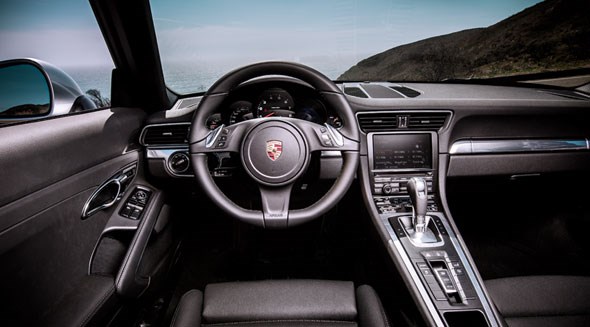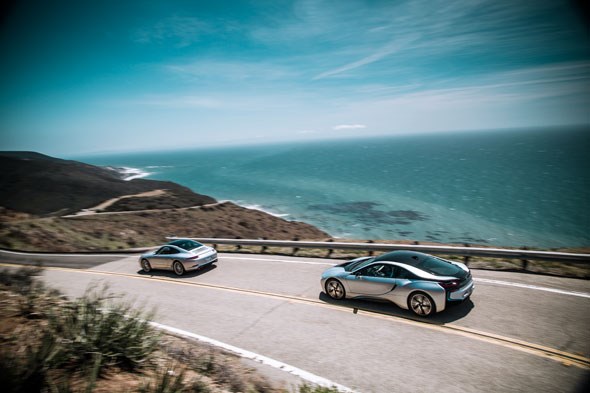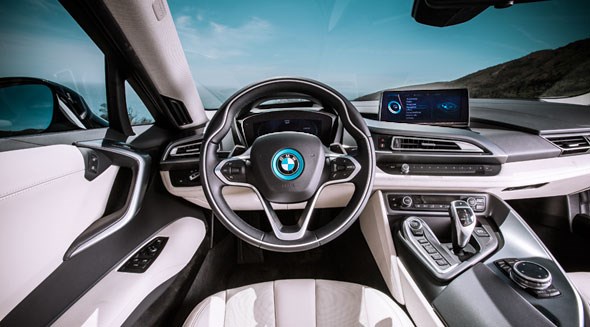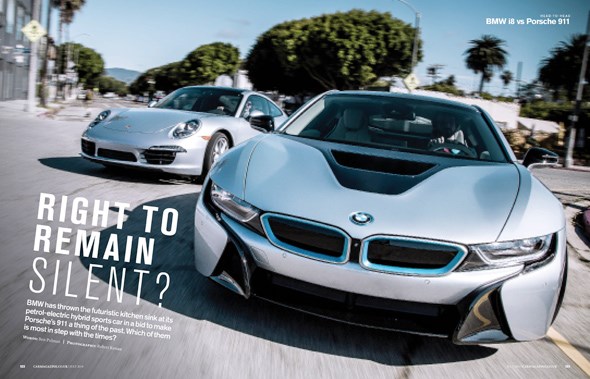Here’s the conundrum: the BMW i8 is a petrol-electric hybrid sports car that’s as fast as a Porsche 911 and cleaner and more frugal than just about anything on the road this side of a pure EV. Yet to achieve all that it’s got skinny tyres, a tiny engine, and hundreds of kilos of batteries and electric motors on board. Would BMW not have been better off dropping the M3’s 425bhp twin-turbo straight-six into the i8’s innovative aluminium and carbonfibre chassis, and building a direct rival to the 911 instead?
Or am I being a Neanderthal? Do it that way and the i8 would be a 911 rival, but nothing else, yet by taking a different tack BMW has arguably built a vehicle that’s so much more. And although the 911 is probably the world’s best sports car, it’s hardly a beacon of progressive thinking, as its roots go back to the late 1940s. Those unenamoured with the posh Beetle will argue Porsche engineers have spent half a century trying to overcome the fundamental flaws of its rear-engined layout, rather than starting afresh and truly innovating. We’ve brought the pair together in Los Angeles, though the 911 is here as much for context as it is for comparison.
The i8 is a clean-sheet design. The chassis is aluminium, and it cradles an electric motor in the nose, a spine of lithium-ion batteries running between the axles, and a turbocharged petrol engine just ahead of the rear wheels. On top of that sits a carbonfibre-reinforced plastic (CFRP) passenger cell – almost like a pick-up truck’s body-on-frame construction – and it’s all wrapped up in a thermoplastic skin.
The batteries weigh around 100kg, the electric motor and associated gubbins the same again, but the i8 is only 85kg heavier than the 911 because every facet has been rethought. The instrument panel support is made entirely from magnesium, foam technology for the air vents reduces weight by 60%, chemically hardened glass is just 0.7mm thick, and the engine has a mere three cylinders…
That’s right, this is a £100k supercar with a mere 1.5-litre triple, so owners best ready themselves to brag about performance between the pumps rather than off the line. Or maybe both, as there’s method to BMW’s madness: for the most part you get the economy benefits of the downsized engine and electric motor (the claim is that the i8 is 300% more efficient during urban driving than its competitors) but the two also combine to produce 357bhp, 420lb ft, and 0-62mph in 4.4 seconds. That’s more power – and way more torque – than the 911 here in base 3.4-litre Carrera spec, and an identical acceleration figure. The downside is, even with a £5000 discount courtesy of the UK government’s OLEV grant, at £94,845 it’s £20k more expensive than the Porsche.
If you like the limelight it’s worth every extra penny. As we roll through Santa Monica and Venice in morning rush-hour, the i8 in silent electric mode, the 911 making the occasional sop to the environment when the stop/start system cuts the engine at red lights, the Porsche may as well be invisible. Every cameraphone and every finger points at the BMW. Jaws drop, windows roll down, you’re tailed through traffic, and because this is extrovert LA and not aloof London, no one is too embarrassed to bombard you with questions. A pair of Veyrons wouldn’t attract this kind of attention.
The i8 doesn’t look like a production car, rather a one-off experimental prototype: there are no visible exhausts, BMW’s trademark kidney grilles are blanked off, the sills shrink-wrap in behind the rear wheels as if there’s no engine back there, and the bodywork folds up from the doors and cascades down from the roof, never meeting but eventually bookending the tail lights. The only visual faux pas is that directly from behind (and once you’ve seen this, you can’t stop seeing it) the i8 appears to be squeezing a miniature 911 out of its bottom.

That’s all it’s emitting as we amble through LA’s concrete jungle though. Rather than the single-digit fuel consumption typical of a supercar stuck in traffic, you thumb the eDrive button on the centre console and, charge willing, the i8 will run for 23 miles on its batteries with zero tailpipe emissions. Nothing too new there, as we’ve seen plug-in hybrids (of which the i8 is one) before, but from Audi A3s to Volvo V60s they’ve all been conventional cars with the electric bits tacked on. And although the purpose-built Porsche 918 boasts a decent electric range, its ability to run on batteries is a gimmick when the primary powertrain is a race-derived 4.6-litre V8 with 599bhp. Not so the i8 – its EV mode feels like a core part of its repertoire.
Just try and forget it’s the front wheels doing the driving. The three-cylinder petrol engine turns the back axle, but the electric motor is mechanically independent and powers the front wheels, meaning when the i8 is at its cleanest, you feel dirty for fawning over a front-wheel-drive BMW sports car. For my sins I repeat ‘I love the M3’ one hundred times.
It’s the only noise in the i8. With the petrol engine off there are none of the noises or vibrations, the sounds and the sensations (both good and bad) you’ve always associated with driving. Imagine living your whole life in a city, then finally making the move to the countryside, stepping outside that first morning, and hearing… nothing. It’s stress-free, tranquil – in eDrive the i8 sounds like the Cotswolds.
Without a roaring engine over your shoulder, the hush brings other elements of the i8 sharply into focus too. Straight away you sense the rigidity of the twin chassis; the surprising firmness (but not harshness) of the ride; that the blue seatbelts bring a sash of welcome colour to a cabin that is nowhere near as radical as its i3 sibling’s interior; that there’s not a single squeak or rattle; and that you sit quite high, with limited headroom.
Switch to the 911 and the famous flat-six dominates. There’s a distinct, dry cough as the starter motor churns over the horizontally opposed cylinders, and once it’s alive you can feel the engine deep down behind you, fizzing up through the chassis and into your seat with a rough throb that clears and harmonises as you blip the throttle. Time to take this pair out of town.

We join the steady flow of traffic heading north on the Pacific Coast Highway towards Malibu, the i8 now in Comfort mode, the 184lb ft from its 96kW electric motor pulling like a punchy little diesel engine, but without any of its clatter. It can run solo up to 75mph, but beyond that, or if your right foot gets over-zealous earlier, the three-pot engine chimes in – mercifully with more elegance than the two-cylinder in the i3 Range Extender, which barges in on proceedings like a UKIP aide. The seamless blending between the electric and hybrid modes is the best I’ve experienced, but you’d rather know what it’s like hurtling through a couple of canyon roads in the Santa Monica mountains, right?
Pull the gearlever towards you and the i8 switches into Sport mode. Some of the changes are subtle: extra weight is added to the steering by reducing the assistance, but it retains a little of the indecisiveness around the straight-ahead that afflicts many electric systems; and although the dampers become firmer, it’s a small difference – this isn’t a McLaren P1 suddenly 300% stiffer.
The engine’s now a different animal though, from gentle pussycat to dog-chasing, child-saving Tara the tabby. Or at least that’s the impression you get: the little 1.5 is wildly turbocharged, with a Veyron Super Sport-beating 152bhp-per-litre equating to more power than a Golf GTI, but it’s the digital dials turning red, the pumped-in noise and tiny electric motor attached to the camshaft that actually make the difference.
There’s no switchable sports exhaust so it’s all down to the speakers, but whereas in an M5 you’re constantly reaching for the stereo’s volume control to turn up the V8’s voice, in the i8 you’re suddenly overwhelmed with the acoustics of a throaty, rorty and rather flatulent large-capacity six-cylinder engine. And it’s more flat-six than straight-six too, especially as the sounds emanate not from up front, but from behind you…

And back there an 11kW electric motor transforms the responsiveness of the engine and gearbox. It doubles as a starter motor, but when you downshift it flicks up the revs like there’s a lightweight race-spec flywheel with no inertia, giving the impression that the triple has the same liveliness as the instant-torque e-motor up front. BMW chose a six-speed automatic because it’s lighter than the newer eight-cog ZF transmission, but with that electric helping hand it does a passable impression of the M3’s dual-clutch ’box.
Does it drive like an M3 though? The chassis is actually relatively unsophisticated, with none of the 918’s torque vectoring, as that would demand a second electric motor up front, and with the emphasis on weight reduction there’s no limited-slip diff at the rear either. Yet because the motors and batteries and engine are all inside the wheelbase, and mounted so close to the ground, the i8 feels lithe and agile and responsive. In other words, properly mid-engined, with a palpable sense of lightness.
Body control through the swooping canyons is excellent as well, and the brakes are brilliant too – strong, but with remarkably smooth and progressive travel underfoot, and none of the leadenness usually found when regenerative and hydraulic systems are trying to combine. Exactly what you need – and expect from – a proper sports car. Apparently it took BMW two-and-a-half years to get the pedal feel right, and in the future, more so than ever, it’ll be the engineers who can integrate and calibrate these multitude of systems that’ll build the best cars.
The drivetrain is nearly as impeccable. From a standstill, with the front wheels pulling and rear wheels pushing, it feels every bit as quick as its 4.4sec claim, and from low revs there’s the instant punch of the electric motor to bolster the petrol engine. The top-end feels reasonably strong too, where peak power is being produced. But the rev limit is surprisingly low, and sometimes, in the middle of a corner, when you’re expecting that instantaneous torque, the i8 takes a moment to punch forwards.
And it’s in those corners that the weaknesses of the i8’s philosophy also reveal themselves. The new M3 has 255- (front) and 275-section (rear) 19in tyres, but the i8 uses narrower but larger diameter wheels to retain the same size contact patch while reducing energy-sapping rolling resistance. But an M3 has a stiff front-end and wide rubber to really lean on, while the i8 feels relatively soft, and the optional wider tyres on our test car (215/45 R20s, rather than 195/50 R20s) soon start to squeal, then scrub wide when pushed.

It’s a safe and benign set-up with relatively low limits, the electric torque delivered through the front wheels actively limited by the steering angle so it doesn’t drag you into understeer, while at the rear there’s not enough power to overcome the grip and traction of the 245/40 R20s. Wider tyres at the front, and narrower ones (or more power…) at the back, please.
After the i8, the 911 feels downright naughty, an antiquated old-school rebel that doesn’t give a damn. The PDK twin-clutch gearbox will decouple the engine if you lift off the throttle when you’re cruising, dropping the revs to around 800rpm, but it’s first and foremost a sports car. Whatever jibes we make about its antique foundations, there are benefits too, including great visibility to all sides, a properly low driving position, +2 rear seats that look a little more useable (I’d even fit back there!) and a bigger boot. And although the latest 991-generation feels less rear-engined than any of its predecessors, after a stint in the i8 not only do you straightaway sense where the flat-six is, but you can also feel the added traction it brings, pushing the fat rear tyres down into the tarmac.
Its limits are much higher, to the extent you’d have to be a real hooligan to get the front tyres howling like the i8’s. The steering is crisper as well, more responsive initially than in the BMW, a little heavier too, and the shift paddles on the wheel click more sharply. The PDK ’box can swap gears smoothly and unobtrusively, snap through the changes quickly in Sport, or add a little extra emotive thump in Sport Plus.
The naturally aspirated engine doesn’t have the instant, zero-rev torque of the i8, but it feels faster, building and building and building, getting stronger at 4000rpm, and then going and going again, the sonorous howl enveloping and immersing you in the experience of driving. It never quite punches as hard at the top end as the 3.8-litre Carrera S, but you’ll do well to push beyond third gear on a good, twisting road. And you’ll do well to avoid the firmer of the two damper modes too, the Sport setting distracting the nose with a few too many surface imperfections. More focused and single-minded is how the Porsche feels.

Where does that leave the BMW? Will you accuse me of being a soft-touch if it’s not criticised as an inferior drive to the 911, or is that missing the point, because a) what is as good as the Porsche, and b) look at all the handicaps the i8 must carry. BMW has done something different, done that something very well, and depending on your viewpoint, done it better too. We should commend the bravery, if that doesn’t sound too patronising.
The engineering isn’t more advanced than what’ll you find in the 918, but the paradigm shift to a properly downsized engine is. It introduces new emotions to the sports car, like the thrill of silence, but has a dual personality to still deliver traditional highs; going forward, whether willingly or not, we’ll be forced to recalibrate and accept that horsepower and 0-62mph times aren’t the be-all and end-all. These changes won’t come cheap to begin with, and even senior BMW bosses admit the i8 (and the philosophy behind it) will be a stretch too far for some, even many. But if this is version 1.0, it’s a helluva first attempt.
Need a victor? How about this: if you had the last gallon of petrol on Earth, would you put it into the 911 and go all out, or put it into the i8 and go a little further? Right now, I’d choose the bang over the gradual whimper.
Then again, if we picked the i8 rather than the 911, we might not have to make that decision quite so soon.
>> This feature originally appeared in the July 2014 issue of CAR magazine. If you like what you see here, check out our free digital preview and best subscription rates here
